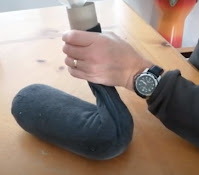A dehumidifier aka damp trap is an apparatus that removes atmospheric humidity. It becomes useful when moisture can degrade or even destroy products sensitive to it (moisture). This post will discuss the dry method. Another or wet method (image below) is discussed in a separate post.
 |
| Dry Method |
You will need:
- a desiccant. Ones already discussed in the DIY movement and relatively easy to find include those in the list immediately below. See list of desiccants. (The CaCl2 used in the wet method is the overall favorite for several reasons that include the fact that it is environmentally friendly and, unlike options like the silica gel, is not limited by a maximum absorption capacity. The matter related to the absorption capacity is especially important when tending to the dehumidifier is not an available option, as when freighting goods over an extended period.)
- Silica gel
- Cat litter made of silica gel (from pet stores).
- A porous container for the desiccant like a sock or flat hard plastic container with holes in the lid.
- Expiry indicator. A scale. Note the weight of the desiccant in its container. If you know its maximum capacity, routinely check its weight to know when that capacity has been reached.
- Heat source for recycling gel. Silica gel can be recycled by dehydrating them in the sun, on a radiator, lightly heated over or other heat source until they return to their dehydrated weight for re-use.
- Location with lingering humidity. Place the DIY dehumidifier in any space that does not experience movement. In other words, avoid door ways because they allow movement of air which prevents moisture to settle. Instead, place the DIY dehumidifier in closed spaces like cupboards, closed small rooms or enclosed basements.
CONTENT RELATED TO HOW TO MAKE A DIY DEHUMIDIFER
- A desiccant is a substance that absorbs atmospheric humidity. List of desiccants.
- YouTuber Monkeys Uncle Dubz Club illustrates how he uses the dry method using a flat plastic tray whose lid has holes to allow the moisture to enter the trap.
- Read about the wet method.



No comments:
Post a Comment